10 classic Abarths brimming with Italian style, performance, and heritage
Racing was in Carlo Abarth’s blood. In 1933, the 25-year-old engineer designed a sidecar in which he beat the Orient Express train in an epic, 800-mile race from Vienna, Austria, to Ostend, Belgium. That was only the beginning.
Abarth moved to Italy in 1934, where he met Ferdinand Porsche’s son-in-law Anton Piëch and eventually married Piëch’s secretary. Abarth didn’t just find love in Italy; he forged a friendship with Ferry Porsche that ultimately led to the creation of the company that bears his last name. Seventy years after Abarth hung an open-for-business sign in 1949, the company with the scorpion logo was in the spotlight (again) at the Geneva International Motor Show.
When an accident ended Abarth’s racing career in 1938, he joined Ferry and fellow engineers Rudolf Hruska and Piero Dusio to create Compagnia Industriale Sportiva Italia (CIS Italia, later becoming Cisitalia). Eleven years later, Abarth left ailing Cisitalia to start his own company with driver Guido Scagliarini.
Abarth initially specialized in making race cars and high-performance mufflers for production cars, but the release of the Fiat 600 in 1955 opened a world of opportunities for the then-young company. Abarth quickly identified a market for a quicker, sportier version of the car that remained reasonably affordable, and he channeled the lessons he’d learned from years of racing and making mufflers into the Fiat-Abarth 750. Coachbuilders like Zagato and Allemano made the model even more alluring by turning it into coupes and convertibles.
Abarth’s star power continued to rise during the 1960s, as the 750 piled up wins and set several international speed records. “Win on Sunday, sell on Monday” held true, and the sales of Abarths sky-rocketed.
Like Amedeo Gordini, Carlo Abarth became a god-like figure in the world of racing. The clout he carried helped him sell his company to Fiat in 1971. By then, Abarth’s best days were behind it, and it oscillated between quiet and dormant until Fiat resurrected the name as a performance sub-brand in 2007.
Abarth turns 70 in 2019. With a lot of empty floor space to fill due to major brands (like Ford) staying home, the Geneva International Motor Show’s organizers asked noted Swiss collector and former Abarth factory driver Engelbert Möll to display his personal collection of classic Abarth models in the Palexpo Convention Center. We’re glad he agreed; his collection is one of the most impressive ones around, and the Abarth brand did nothing to celebrate its own 70th anniversary at the show.
Crowd pleasers like the 500-based 595 SS were present, but the display also featured many rare, lesser-known models from a company whose history is more diverse than many enthusiasts realize.
1949 Abarth 205 A
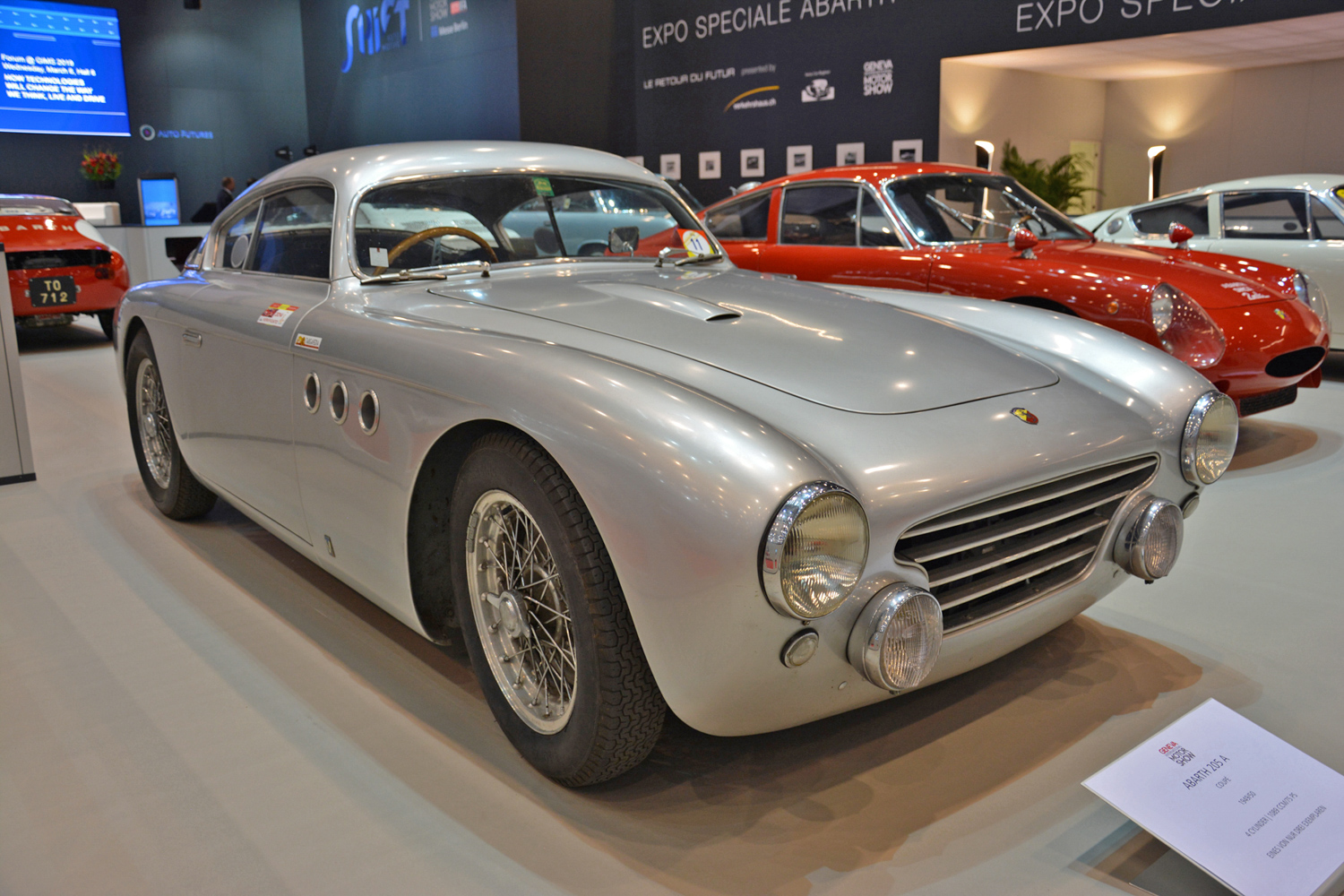
Carlo Abarth began working on the 205 A immediately after he left Cisitalia. Michelotti designed the coupe’s curvaceous body, while coachbuilder Vignale manufactured it out of aluminum in order to keep the car’s weight around 1750 pounds. It was powered by a Fiat-sourced, 1.1-liter four-cylinder engine that Abarth upgraded with a redesigned intake manifold, two Weber carburetors, and an exhaust system designed in-house. The modifications increased the four’s output to 83 horsepower, which was impressive for such a small engine.
In 1950, Guido Scagliarini drove the original 205 A to a first-place finish in the 1100-cc category of the Coppa Intereuropa held on the Monza track. The car participated in other competitions during the early 1950s, including the Mille Miglia, and it turned heads at the 1950 Turin Auto Show.
The 205 A cost as much as a Ferrari with a 2.0-liter engine, so sales were low. Abarth only built three examples of the car, including an upmarket variant that Carlo daily-drove. Surprisingly, the three cars managed to survive 70-year beating of road and track use.
1957 Abarth 500 Coupe
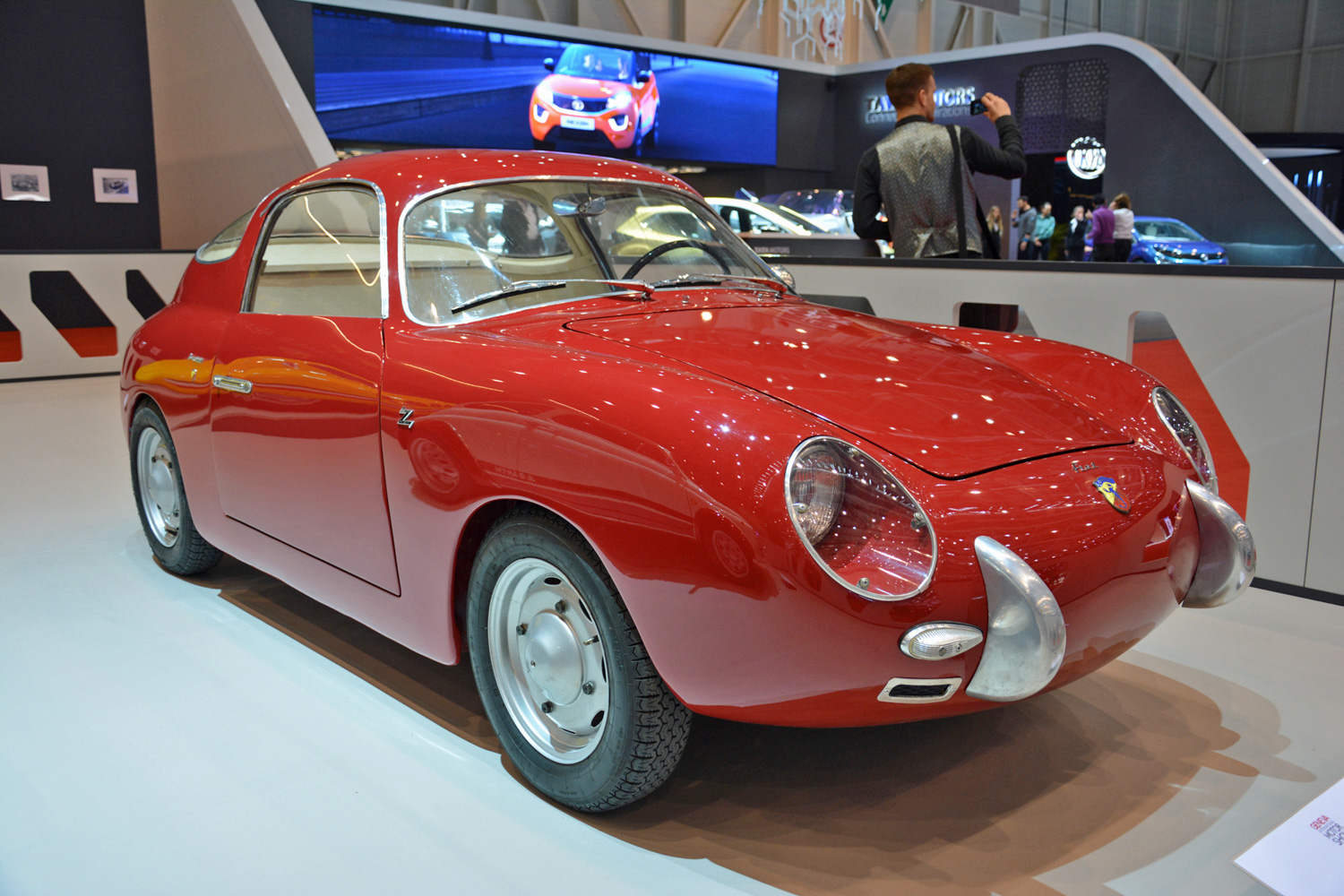
Abarth and Zagato envisioned the 500 Coupe as a cheaper, less powerful alternative to the emblematic 750 with the famed double-bubble roof. Both cars looked a lot alike, but the 500-powered model received a smooth roof panel, and its smaller engine didn’t require extra air intakes on top of the deck lid to breathe. Its wheels kept the 500’s wide bolt pattern, which was one of the few visual links between Fiat’s mass-produced, entry-level model and this hand-built, race-ready coupe. The rear license plate light housing was another.
Power came from an Abarth-tuned version of the 500’s 479-cc, two-cylinder engine. The air-cooled unit made 26 horsepower, a massive increase considering buyers of the 500 settled for only 13 hp in 1957.
Abarth’s record keeping was approximate at best, but most historians agree about four examples of the 500 Coupe were built during the late ’50s. In contrast, the number of 750s built lies in the hundreds. The 500 Coupe is largely forgotten in 2019, though Abarth and Zagato paid a vague homage to it in 2011 when it unveiled the Fiat 500 Coupe by Zagato during the Geneva show.
1957 Abarth 750 Spyder

While the race-winning 750 remains one of Abarth’s best-known classic models, the Spyder version of the car is as unknown as if it had never existed. Abarth and Zagato built approximately six drop-top 750s during the late 1950s in a bid to reach a wider audience. The hardtop 750 was built to race; the Spyder was more of a celebrity-friendly boulevard cruiser with the soul of a race car. It received a more stylish design with mini tail fins cribbed from much bigger American convertibles, more chrome trim for an upmarket look, and a better equipped interior.
Like the 750, the Spyder was based on the 600. It used a 747-cc evolution of the 600’s water-cooled, four-cylinder engine whose output grew from 23 to 44 hp. British magazine Autocar tested a 750 Spyder in 1958 and reached the hair-raising speed of 95 mph.
Historians disagree on why Spyder production remained in the single digits. Some claim Zagato struggled to keep up with demand for the hardtop 750 and didn’t have the production capacity to make more convertibles. Others believe Carlo Abarth didn’t like the Zagato’s design, which would explain why he later handed the task of making a top-less 750 to Allemano.
1958 Abarth 500 Record

In the 1950s, Abarth saw no limit to the pocket-sized Fiat 500’s performance potential. The firm tuned the standard model a few months after its introduction and sent it straight to the Monza track, where the records it set helped kick the car’s career into high gear. It quickly turned it into the aforementioned coupe, but the most extreme 500-derived model was the streamlined, single-seater record car designed with input from Pininfarina.
The 500 Record shared precious few components with the humble 500; it was built on a tubular chassis. Pininfarina put a tremendous amount of effort into making the body as light and as aerodynamic as possible. The driver entered the tight cabin through a front-hinged hatch that incorporated a wrap-around windshield for improved visibility. Pininfarina drilled holes through the hinges to keep weight in check, and it installed covers over the four wheels to reduce turbulence in the wheel wells. Engineers achieved a 0.25 drag coefficient, which places the car nearly on par with a 2019 Hyundai Ioniq (0.24).
Abarth installed a 500-sourced, 479-cc two-cylinder engine rated at 36 hp, which was a lot considering the Record weighed a scant 815 pounds.
Sent to Monza, the Record covered 28,000 kilometers (about 17,000 miles) in 10 days at an average speed of 116.38 kph (about 72 mph). This was an incredible feat for Fiat, Pininfarina, and Abarth.
1963 Abarth Simca 1300 GT
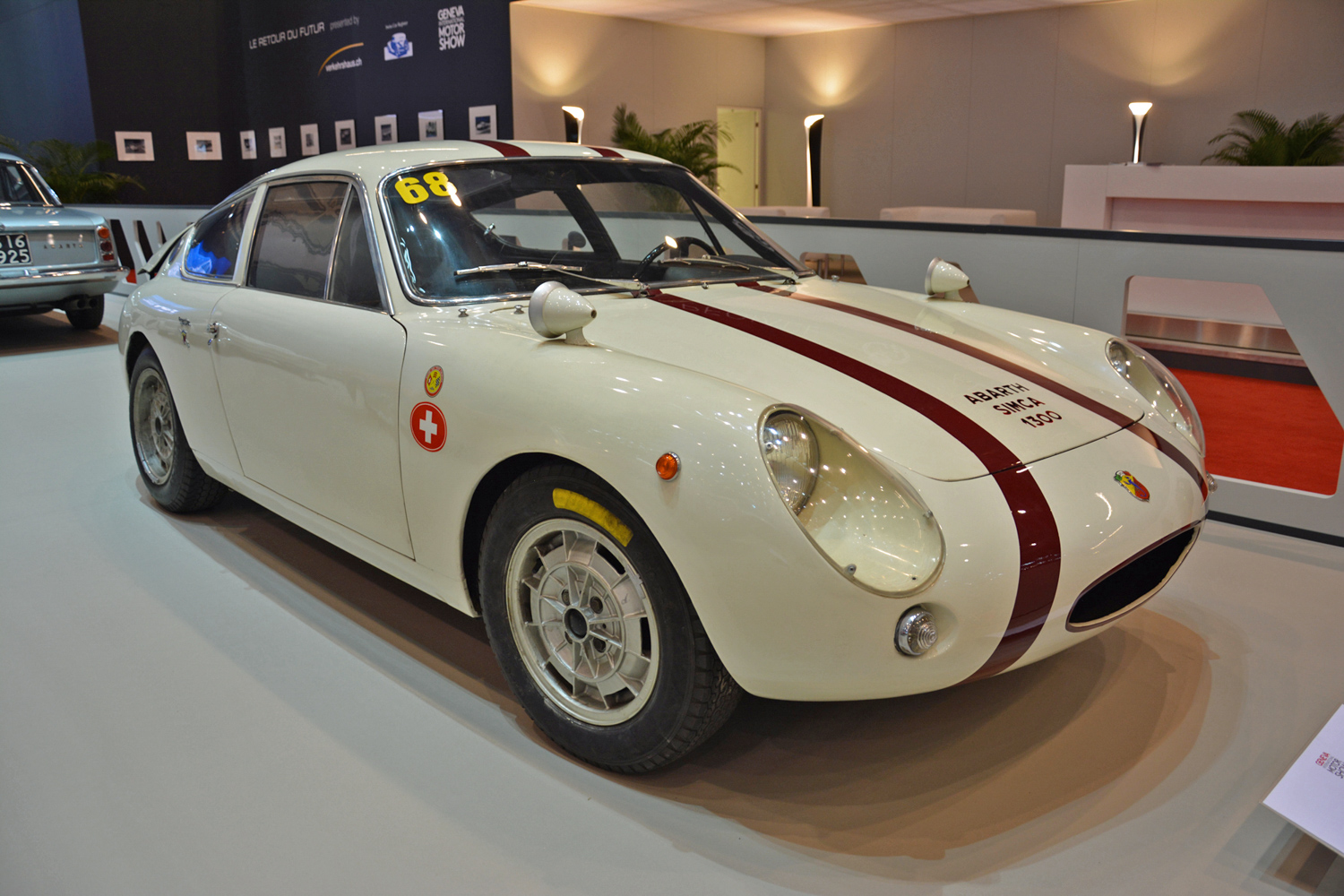
Abarth made a name for itself by tuning small, rear-engined Fiat models, but it also worked with other car manufacturers, including Simca. The fact that Fiat still owned part of Simca at the turn of the 1960s facilitated the collaboration. Henri Theodore Pigozzi, the man who helped Fiat create Simca and ran it for decades, allegedly contacted Abarth in the months leading up to the 1000’s release to ask for two high-performance variants of the car. The first one needed to be a hotter version of the regular-production model. The second one was a coupe based on the production car, but fitted with a racing-specific body, and upgraded with a wide array of mechanical modifications.
The Simca-Abarth 1150’s promising career was cut short when Chrysler began buying into Simca and Pigozzi quit. However, Abarth received a shipment of bare 1000 chassis to turn into race cars. After experimenting with a 1.0-liter engine, Abarth adopted a 1.3-liter that delivered 128 hp thanks in part to a pair of big Weber carburetors. The four shifted through a Simca-sourced four-speed manual transmission, but clients could order an Abarth-designed six-speed manual at an extra cost.
Abarth entered four 1300 GTs in the 1962 edition of the 24 Hours of Le Mans. One car finished 14th; the other three dropped out of the race. The model fared better in 1963, when it stunningly earned 90 first-place finishes at a wide variety of events, including the 12 Hours of Sebring.
1965 Abarth 2400 Coupe

In the late 1950s, Abarth mostly made small, high-performance cars either based on an existing Fiat model, or built using Fiat-sourced components. The company also quietly dabbled in stately grand tourers, like the 2400 Coupe, that were equal parts quick and luxurious.
Like the firm’s smaller models, the 2400 Coupe started life as a Fiat. It traced its roots to the high-end 2300 Coupe. Abarth raised the straight-six engine’s displacement from 2279 to 2323 cubic centimeters to obtain 157 horsepower. The brand also installed three Weber carburetors, lighter pistons, and a brand-new exhaust system. Michelotti designed an elegant, well-proportioned coupe body that could nearly pass as a member of the Ferrari family, and Allemano handled production.
Abarth’s records indicate a few dozen 2400 Coupes were built. They were hand-made, so no two cars were exactly alike. The aluminum-bodied example in Engelbert Möll’s collection was Carlo Abarth’s personal car. The grandiose coupe illustrates a rarely-seen facet of the Abarth brand, one it later gave up on to focus entirely on flat-out performance.
1965 Abarth Simca 2-Mila

Abarth’s bet had paid off. Even with little support and almost no enthusiasm from Simca, the 1000-derived 1300 GT had become a force to be reckoned with on race tracks around the world. The company’s ambitions didn’t stop at the 1300-cc category. In 1964, it stuffed the OT 2000’s 177-hp, 2.0-liter four-cylinder in the engine bay, and made the coupe more stable at high speeds by extending its rear end and integrating a spoiler into the decklid.
The modifications transformed the 1300 GT into a monster of a race car that required serious driving skills to tame. Abarth named it 2 Mila, a name which means “two thousand” in Italian, and refers to the engine’s displacement. Brave and determined customers could order a 192-hp version of the engine, and the 2 Mila’s output later grew to 202 hp thanks in part to bigger carburetors.
Simca severed ties with Abarth in 1965, and it ultimately founded an in-house racing department which created the race-winning 1000 Rallye. Abarth continued building—and racing—Simca-based cars for several more years, however.
1966 Abarth OT 2000
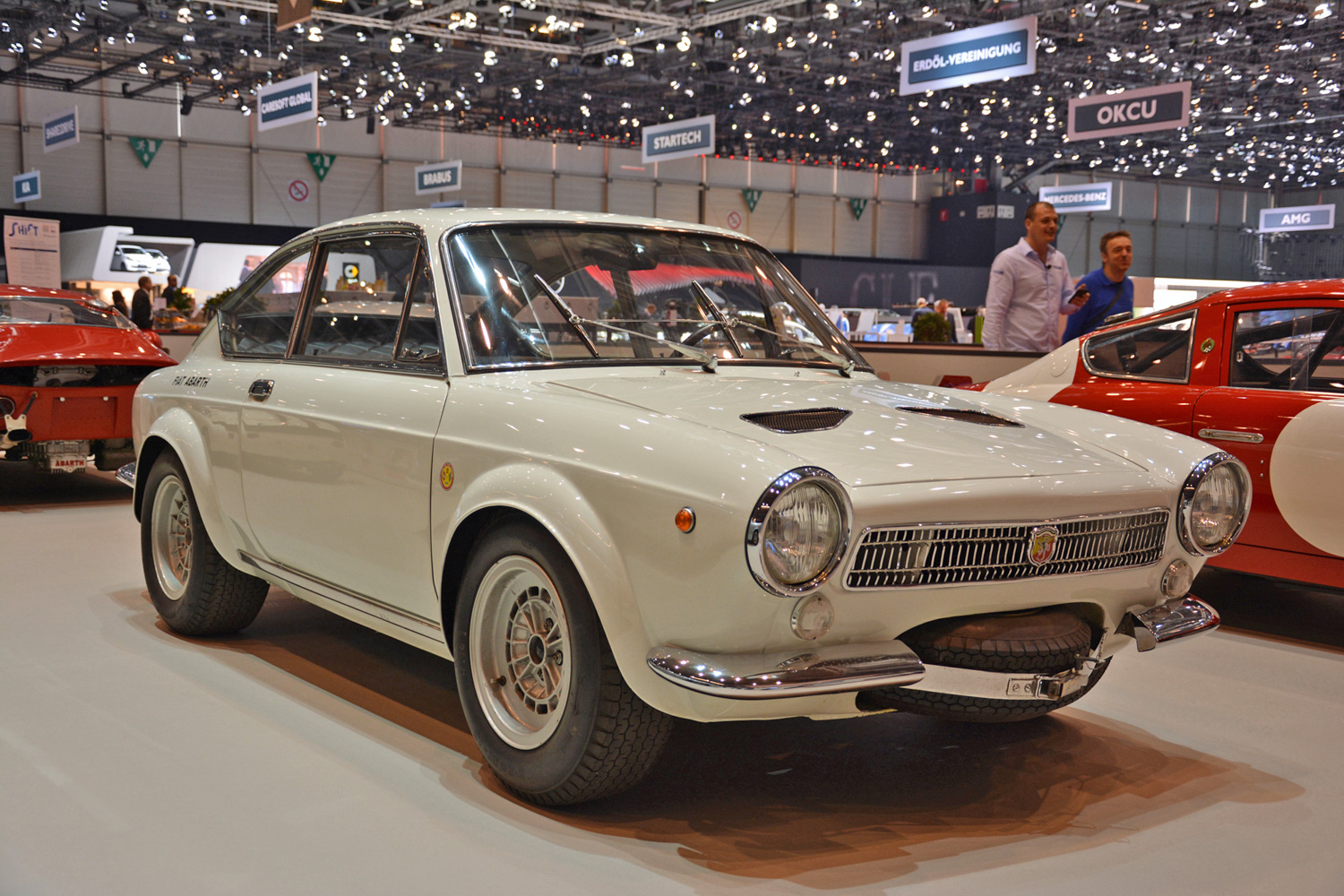
Abarth tried replicating the success of its 500- and 600-based models by releasing hotter variants of the Fiat 850 introduced in 1964. The strategy should have worked, especially because the coupe and convertible variants introduced by Fiat in 1965 gave Abarth a full catalog of volume-produced models to build on without having to knock on a coachbuilder’s door.
One of the most extreme 850-based models was the OT 2000 presented during the 1966 Turin show. Based on the 850 Coupe, it received a 185-horsepower version of the 2 Mila’s 2.0-liter four-cylinder engine with more torque to make it more usable on public roads. The four spun the rear wheels through a five-speed manual transmission, and it sent the 1500-pound OT 2000 to a top speed in the vicinity of 150 mph.
It looked like a 150-mph car, too. Abarth added fender flares to cover the wider wheel and tire combination. It also re-located the radiator from the engine bay to the trunk, which required stuffing the spare tire horizontally in a storage compartment chiseled into the front end. The long, straight exhaust pipe that extended the car’s length by a few inches removed any lingering doubts about its identity. It wasn’t a run-of-the-mill 850.
Abarth’s 850-based models weren’t as successful as the company’s earlier cars. In hindsight, they were too expensive, which alienated many potential buyers, and their mechanical components—which often came straight from the pit lane—were too delicate to withstand the hustle and bustle of life off the track. Only five examples of the OT 2000 were built.
1968 Abarth 1000 TCR Radiale

On paper and in the metal, the Abarth 1000 TCR Radiale stands out as the most extreme evolution of the Fiat 600, a model introduced in 1955 to put Italy on wheels. The 108-hp, 1285-pound TCR was built to compete in the Group 5 category, where relatively loose regulations allowed a wider scope of mechanical modifications. Abarth took advantage of the permissive rules by dropping the engine to lower the car’s center of gravity in order to improve handling.
The 1.0-liter four-cylinder received a head with hemispherical combustion chambers (so, yes, Mopar fans, that thing’s got a hemi). It was developed in-house by Abarth, and it wasn’t found on any series-produced Fiat model. Given a long enough stretch of tarmac, the TCR could reach a top speed of about 124 mph. Suspension modifications helped pilots make the most of the engine’s grunt while keeping the front end pointed in the direction of travel.
Registered in Venezuela, the 1000 TCR Radiale displayed in Geneva won the 500-kilometer race held on the Nürburgring in 1968.
1970 Abarth 595 SS
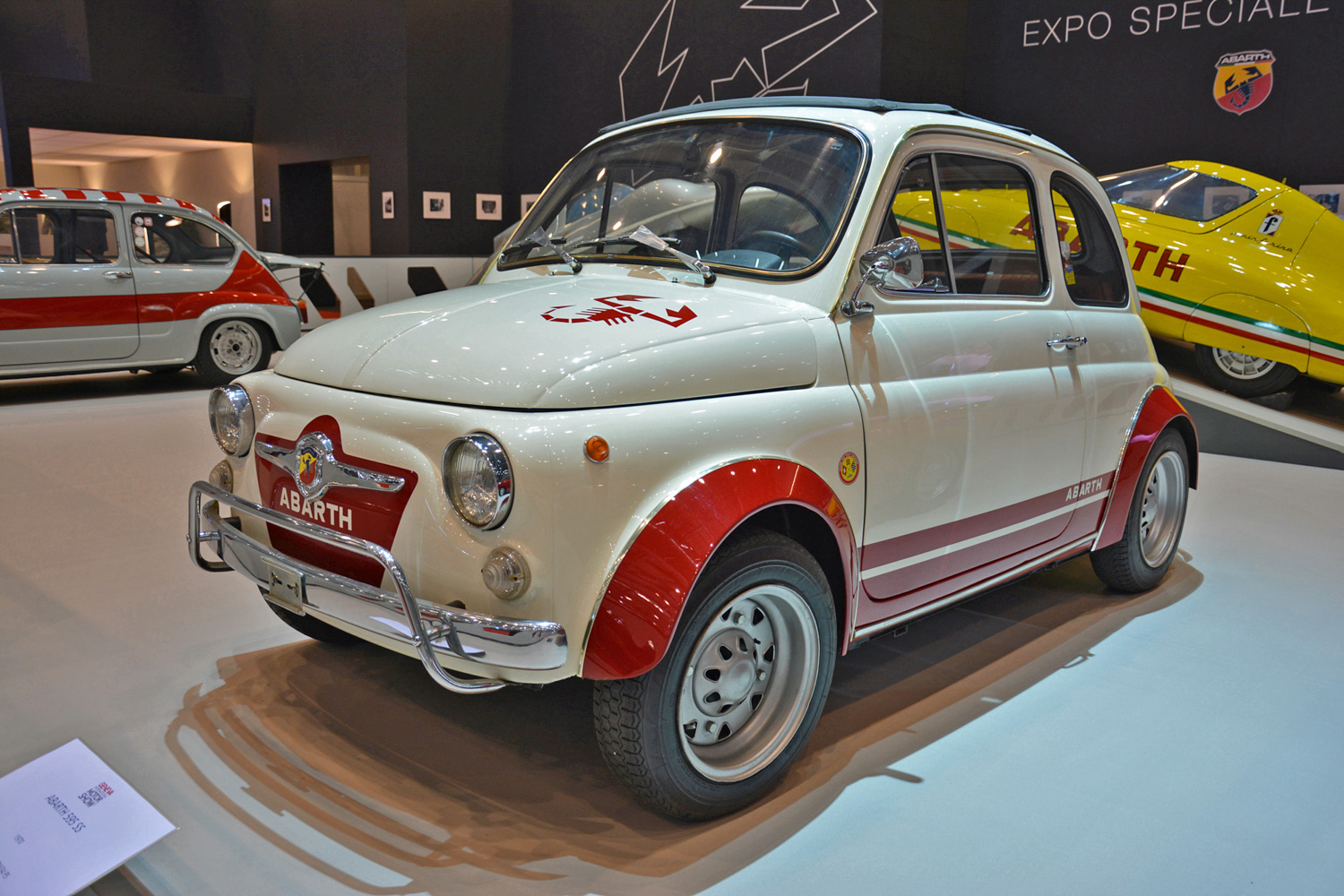
Abarth introduced the 595 as a homologation special at the 1963 Turin show. Starting with a Fiat 500, a car that was anything but sporty in its standard configuration, the firm fitted a 594-cc engine (hence the name, rounded up) rated at 27 horsepower, a nearly 50-percent increase over the regular-production model. It could reach 74 mph, which surprised more than a few Alfa Romeo and Lancia drivers on Italy’s autostrada. The SS variant released in 1964 boasted an 80-mph top speed thanks to a 32-hp evolution of the twin.
Abarth built its first 500-based models by purchasing complete cars from Fiat and modifying them in its workshop. Starting in late 1963, Fiat agreed to provide Abarth with partially-assembled cars. The deal streamlined the production process. Customers could either buy a finished 595 from Abarth, or purchase wooden crates containing all the parts needed to turn a homely 500 into a hot rod.
Production of the 595 ended in 1971. In Europe, where Abarth operates with considerably more independence than in the U.S., the brand resurrected the 595 SS nameplate for its version of the modern-day 500. The American-spec model is known simply as the Fiat 500 Abarth.

